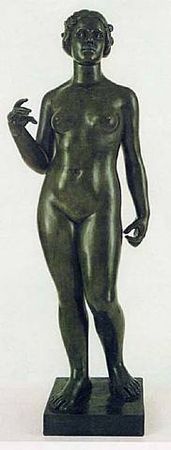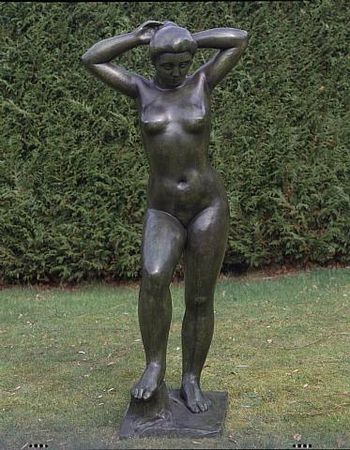Aristide Maillol (Banyuls 1861 - Id., 1944) La montagne,1905-1906 et plusieurs autres sculptures en vente
Aristide Maillol (Banyuls 1861 - Id., 1944) La montagne,1905-1906
Etude. Bronze à patine noire. Alexis Rudier Fondeur Paris. Numéroté 2/6. Monogrammé. H. 28 cm, L. 27,9 cm, P. 19,7 cm. Estimation : 100 000 / 120 000 €
Provenance : Ursel Berger et Joerg Zutter, Maillol, Lausanne, 1996, version en pierre illustrée, p.167.
Littérature : Galerie Dina Vierdy
Ancienne collection privée, New York
"… Il vit dans la misère, ce n'est qu'en 1889, qu'il fait la connaissance d'Antoine Bourdelle, pauvre lui aussi mais dont le foyer l'accueille. En 1893, il ouvre à Banyuls un atelier de tapisseries et épouse l'une de ses ouvrières. En 1896, il expose ses premières sculptures au Salon de la Société Nationale des Beaux-Arts.
Il fait à cette époque la connaissance de Gauguin. Il installe son premier atelier à Villeneuve-St-Georges, rencontre Picasso, fréquente les Nabis. Le marchand Ambroise Vollard achète quelques sculptures et organise une exposition de ses sculptures en 1902, succès.
En 1905, Maillol, grâce à Rodin, fait la connaissance d'un collectionneur allemand, le Comte Harry Kessler, qui devient son mécène… Nombre de ses grands bronzes seront placés sur la pelouse du Carrousel en 1964 grâce à la donation de Mme Dina Vierny, son modèle préféré de 1934 à 1944 et à la décision d'André Malraux, alors Ministre des affaires culturelles.
Maillol affirme une maturité exceptionnelle dans le rendu du corps féminin, il affectionne les formes pleines, robustes, architecturées et néanmoins harmonieuses, fort éloigné des agitations des attitudes tragiques, du mouvement de Rodin dont il se démarque profondément. Rompant avec la tradition du XIXe siècle, ses oeuvres sont dépourvues de toutes références littéraires, politiques, mythologiques ou sociales …" Pierre Kjellberg, Les bronzes du XIXe siècle, Dictionnaire des Sculpteurs, Les Editions de l'Amateur, pp.476-477.
Et d'autres bronzes disponibles sur le marché :
Aristide Maillol, Baigneuse Cladel, 1920
Bronze, dark brown patina. Signed with the monogram, h: 13 in / h: 33 cm. Contact Gallery for Price www.hammergalleries.com
Aristide Maillol, Baigneuse debout
Bronze, h: 78 cm / h: 30.7 in. Contact Gallery for Price www.dreyfus-drouot.com
Aristide Maillol, Bather Putting up her Hair, 1898
Bronze. : 10 x w: 5 x d: 4 in / h: 25.4 x w: 12.7 x d: 10.2 cm. Contact Gallery for Price www.sladmore.com
Aristide Maillol, La Nymphe aux fleurs, 1931
Bronze. h: 157 x w: 48 x d: 37 cm / h: 61.8 x w: 18.9 x d: 14.6 in. Epreuve d'artiste, Alexis Rudier. One of the four artist's proofs from the total edition of ten. Contact Gallery for Price www.cookfineart.net
Aristide Maillol, Baigneuse debout se coiffant, 1930
Bronze, cast 4/4. h: 157 x w: 67 x d: 59 cm / h: 61.8 x w: 26.4 x d: 23.2 in. Cast by Alexis Rudier, Paris. Contact Gallery for Price www.marlboroughfineart.com
Aristide Maillol, Pour le Monument à Paul Cézanne, 1912-1925
Bronze. Cast by Claude Valsuani, Paris. 2/6. h: 6.9 x w: 12.4 x d: 6.1 in / h: 17.5 x w: 31.5 x d: 15.5 cm. Contact Gallery for Price www.marlboroughfineart.com
Aristide Maillol, Nuit, 1909
Bronze, cast 3/6. h: 17.8 x w: 13.5 x d: 11 cm / h: 7 x w: 5.3 x d: 4.3 in. Cast by Alexis Rudier, Paris. Contact Gallery for Price www.marlboroughfineart.com
Et un résultat pour "La Montagne" chez Sotheby's :
Aristide Maillol, La Montagne
Conceived in 1937 and cast in lead after 1944 in an edition of 6 numbered casts, 4 artist's proofs and 2 estate casts. This work is number 3/6. Inscribed with the artist's monogram M, with the foundry mark E. Godard Fondeur, Paris and numbered 3/6. Lead. 76 by 83 1/2 by 40 1/2 in./193 by 212.1 by 102.9 cm. Est. 2,500,000—3,500,000 USD. Sold 3,065,000 USD
PROVENANCE: Estate of the artist
Acquired from the above by the present owner
LITERATURE AND REFERENCES: John Rewald, Aristide Maillol, London, Paris & New York, 1939, illustration of the smaller terracotta study pl. 120
John Rewald, Aristide Maillol, 1861-1944, Paris, 1950, illustration of the plaster p. 48
Maillol, Exposition-Hommage du Centenaire de sa naissance (exhibition catalogue), Galerie Daber, 1961, illustration of the smaller terra cotta study pl. 15
Hommage à Aristide Maillol (exhibition catalogue), Musée National d'Art Moderne, Paris, 1961, illustration of the stone version
Waldemar George, Aristide Maillol, Neuchâtel, 1965, photograph of the artist with the plaster cast p. 51
Aristide Maillol (exhibition catalogue), Perls Galleries, New York, 1970, no. 58, illustration of a smaller version p. 40
Waldemar George, Maillol, Paris, 1971, illustration of another cast p. 38
Aristide Maillol: 1861-1944 (exhibition catalogue), The Solomon R. Guggenheim Museum, New York, 1975, illustration of another cast pl. 98
Maillol au Palais des Rois de Majorque (exhibition catalogue), Musée Hyacinthe Rigaud-Perpignan, 1979, illustration of a smaller version p. 110
Bertrand Lorquin, Maillol au Tuileries, Paris, 1991, illustrations of the lead version pp. 20-22
Bertrand Lorquin, Aristide Maillol, London, 1995, illustrations of the lead version pp. 136 & 138
Aristide Maillol (exhibition catalogue), Palais des Congrès, Perpignan, 2000, illustration of a smaller version pl. 85
NOTE: La Montagne marks the culmination of Maillol's allegorical renditions of the seated female nude. His original idea for this form dates from the beginning of the century, when he completed his poetic La Nuit (see fig. 2) and the powerful La Méditerranée. Over the next several decades the artist's fascination with the grace and elegance of the seated figure never diminished, and he returned to this motif in the 1930s with La Montagne. The sheer size of this figure was a powerful aesthetic statement in these final years of Maillol's life and instigated his production of other impressive monumental sculptures, including L'Air (see fig. 3) and Monument à Cézanne.
Maillol's model for this sculpture was a young Russian woman named Dina Vierny, whose voluptuous physique bore a striking resemblance to the figures of Maillol's sculptures. Vierny began working with the artist in 1935, and La Montagne was one of the first major works modeled after her image (see fig. 4). Maillol rendered several preliminary sketches (see fig. 5) and four different studies for this sculpture, and ultimately arrived at the final composition in 1936. Bertrand Lorquin has written about the influence of Vierny on this work and the other sculptures Maillol created at the end of his life: "The appearance of this new model in Maillol's life brought about a renewal of his art and gave him the impetus to create the monumental sculptures of his final years. 'I began posing for large monumental drawings and for the carving of Nymphs,' remembers Dina Vierny. 'Next came The Mountain, for which he returned to the projects he had had at the beginning of his life, but with a certain change in the conceptions that determined his work. He wanted to complete the monuments he carried within himself and then come back to painting, which is in fact what he did'" (Bertrand Lorquin, Aristide Maillol, London, 1995, pp. 138-140).
In 1936, the Musée National d'Art Moderne commissioned the first monumental version of La Montagne in stone. Maillol began working on the plaster for this sculpture in 1936 in the large studio of his friend, Kees van Dongen, whose brother Jean assisted him on his casting and stone carving. On December 21, 1936, the photographer Brassaï visited the artist at this studio, and photographed him while he worked on the giant plaster of La Montagne (see fig. 1). In Brassaï's remembrance of that day, he told of how the sculpture nearly collapsed and how Maillol succeeded in stabilizing his massive composition: "the weight of the material has caused La Montagne's left shoulder to begin to slip... Probably the iron armature has given way. Maillol is beside himself, and so is everyone else. Can the disaster be prevented; Van Dongen fetches some planks to shore up the weakened shoulder, while the sculptor tries to strengthen it with freshly mixed plaster. In the end, the sculpture is saved, and two hours later I managed to photograph it with Maillol looking like a midget beside the colossus" (Brassaï, The Artists of my Life, London, 1982, p. 116).
La Montagne was cast by the Georges Rudier and Emile Godard foundries in an edition of 6 numbered casts, 4 artist's proofs and 2 estate casts. This subject exists in two separately cast versions in which the variation occurs in the form of the base. Other casts of this subject are in the following collections:
Jardin des Tuileries, Paris
Norton Simon Museum, Pasadena
Canberra Museum, Australia
St. Louis Art Museum
Columbus Museum, Ohio
Musée Maillol, Paris
Private Collection, Virginia
Private Collection, Texas
Israel Museum, Tel Aviv
Private Collection, US (formerly in the collection of Barbara P. Johnson)
Fig. 2, Aristide Maillol, La Nuit, 1904, bronze, sold: Sotheby's, New York, November 2, 2005
Fig. 3, Aristide Maillol, L'Air, 1938, lead
Fig. 4, Dina Vierny with one of Maillol's sculpture, circa 1937. Photograph by Brassaï
Fig. 5, Aristide Maillol, study for La Montagne, 1936, Fondation Dina Vierny, Musée Maillol, Paris
Fig. 1, The artist with the plaster cast, 1936. Photograph by Brassaï
Sotheby's New York: Wednesday, November 7, 2007. Impressionist & Modern Art Evening Sale www.sothebys.com

/https%3A%2F%2Fprofilepics.canalblog.com%2Fprofilepics%2F1%2F0%2F100183.jpg)











/http%3A%2F%2Fstorage.canalblog.com%2F93%2F20%2F119589%2F66084305_p.jpg)
/http%3A%2F%2Fstorage.canalblog.com%2F77%2F89%2F119589%2F66028126_p.jpg)
/http%3A%2F%2Fstorage.canalblog.com%2F88%2F73%2F119589%2F65085345_p.jpg)
/http%3A%2F%2Fstorage.canalblog.com%2F14%2F16%2F577050%2F64637465_o.jpg)